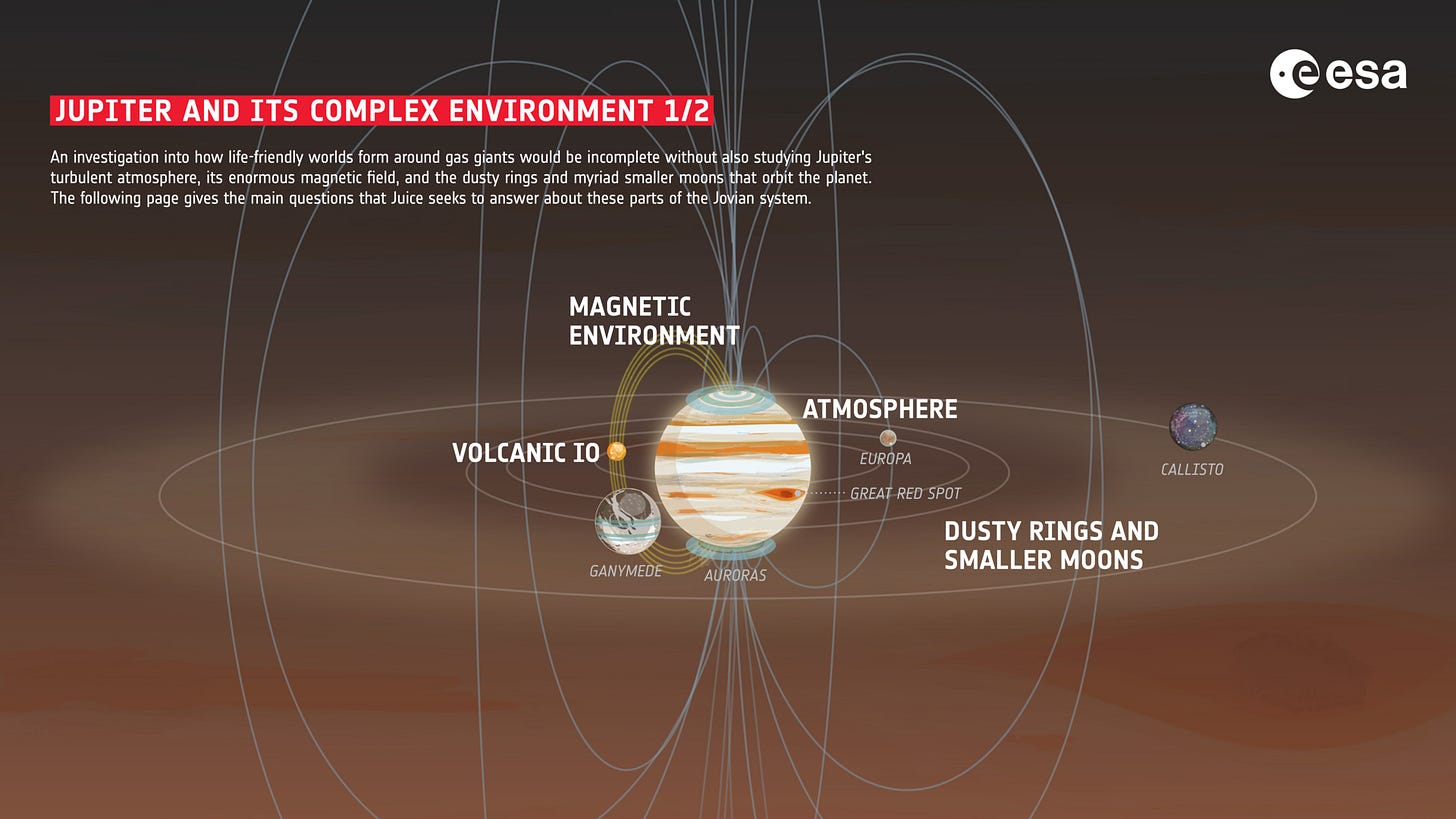#JUICELog: JUICE Science Capabilities
Looking ahead to JUICE's exploration of the jovian system, based on an interview in 2023.
How will the JUICE mission's capabilities improve on the instruments we've had in the Jovian system before? Is there some data set, for example, you're particularly interested in seeing that we've not had before?
The JUICE payload builds on a lot of heritage from previous missions, but seriously "turns the dial to 11" with some of the capabilities, including accessing new wavelength ranges, with higher spectral/spatial resolutions, and better sensitivity than we've had before. For example, the instrument I work with (MAJIS) is superior to the NIMS instrument (on Galileo) and JIRAM instrument (on Juno), in that it can reach longer infrared wavelengths than either of them, allowing us to map water-rich environments within the cloudy layers.

For Jupiter, the most novel instrument is one which works in the sub-millimetre - that's tremendously exciting for an atmospheric scientist, as it allows us to directly measure the winds and circulation high in the stratosphere, a feat that no previous mission has ever accomplished. The stratosphere is the interface between the churning weather of the striped cloud decks, and the ionosphere and space environment above. It'll be fascinating to see how energy flows through this layer, both from above and below.
Staying with Jupiter for a moment, JUICE science can be considered as complementary to Juno. Juno gets exquisite high resolution for a short period of time, as it spins across the cloud-tops during its perijove encounters. The JUICE orbit is designed differently, and whilst our best science will be conducted close to the planet, there are long periods where we can monitor the atmosphere and magnetosphere to see how the Jupiter system changes and shifts over time. It helps that JUICE does not spin like Juno, so it’s more straightforward to stare at the planet for a long time, or to create complicated mosaics to get global coverage. Snapshots of small regions are not enough to understand this complex system, we need to see how it changes over time. My research is trying to understand natural climate patterns within Jupiter's atmosphere, but these create changes in storms, chemistry, and temperatures over multiple years… so we need a long-lived orbiter like JUICE to start to unravel their causes and consequences.
Stepping away from my own field of atmospheric science, one of the most exciting things about this mission is the ability to probe down into the icy surface layers of the satellites. The ice-penetrating radar will see into the subsurface for the first time, searching for evidence of fissures, icy liquid pockets, or the interface between the ice crust and the deep, dark, hidden oceans. These cold frozen realms could host significant new discoveries about the processes shaping icy moons in our solar system. I just can't wait to see what lies below those frozen surfaces for the first time.
What are the big unresolved questions in your field of research and will JUICE help explore them, and if so how?
That's a big question! I think the study of giant planets like Jupiter is evolving into a study of connectivity, of coupling and exchange between very different regimes. For example, how can processes moving material around at great abyss of their interiors be influencing what we see in the atmosphere at the cloud tops? How does energy and material coming in via the aurora and ionosphere influence the stratosphere? And why is it that events in one region seem to have profound consequences on the meteorology tens of thousands of kilometres away? The multi-wavelength monitoring from JUICE's sophisticated instruments will enable the development of a long-term climate database for Jupiter, providing tools that'll help us to better understand this system as "an archetype for giant planets."

Beyond my own field of atmospheres, JUICE will help to contribute to some of the biggest questions in planetary science: how and when did our giant planets form, and can we consider the environments of the icy moons to be habitable? JUICE will help to address the former by studying the atmospheric composition today, which serves as a time capsule for materials built into the giant planet as it was forming. The latter question requires all the eyes of JUICE at once: gravity sounding, magnetic-field sounding, remote sensing imaging and spectroscopy, and sub-surface sounding. That's what JUICE was designed to do, to understand the emergence of habitable worlds around planets like Jupiter. For if the conditions are right for life in these apparently inhospitable icy realms, that could vastly widen our perspectives on what habitable worlds might look like around other stars.

